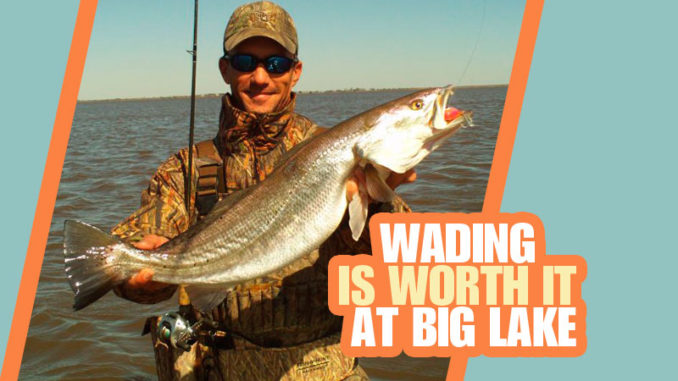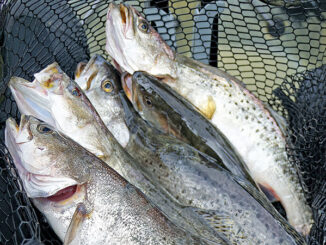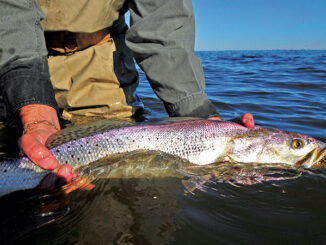
“I hardly do it at all now. That’s a younger man’s sport. Several of my guides do,” said Kirk Stansel, co-owner of Hackberry Rod & Gun Club ((337) 762-3391.)
“February is a really good wade-fishing month for speckled trout. There are quite a few good spots,” Stansel said.
“I would target the east side of the lake from Deatonville to Commissary Point, and wade-fish the shoreline for trophy trout.”
The best places to wade are those with mud bottoms, he said, which warm up in the afternoons, even on the coldest days. Avoid solid oyster bottoms unless it is unseasonably warm.
“Most of the time the water’s clear. Dark mud warms up. That water warms up,” he said. “Baitfish move in on it, and the trout will follow.
“Of course, you want to look for areas that have bait,” he said, and added that brown pelicans diving on the water is a good sign.
Stop the boat, get out and try along a shoreline. However, he cautioned, don’t use a Power-Pole at low tide to anchor the boat because at high tide, the boat will float away. Always use an anchor, he said.
Brave the elements
Naturally, wear good waders and dress appropriately. Stansel and many others wear Simms Fishing Waders, he said.
And don’t let extremely cold weather deter you from going wade-fishing for speckled trout. Afternoons on those frosty days can provide some of the best action for large specks.
And don’t expect to get a bunch of bites, unless it’s unseasonably warm. Two to five bites from quality speckled trout usually is a fair trip during cold weather — but if it’s really warm don’t be surprised to catch 10 to 20.
Stansel said he uses 20- to 30-pound Power Pro braided line with a 2-foot long 30-pound mono leader. Baitcasting or spinning outfits work equally well, as long as you can cast far. He also uses a Boga Grip rather than a landing net, and wears a backpack and a wade belt with a stringer attached.
Stansel, whose personal best speckled trout is a 9-pound, 6-ounce monster (although he caught a 10-pound class fish and released it without weighing it) advises waders to fish along the shoreline and to make long casts.
Big fish
At low tide, generally, the fish are farther from shore while at high tide they are close to the shore.
“You’re not looking for a lot of bites. You’re just looking for a big bite. You really have to be patient. Fish an area and if you don’t get a bite in an hour, try another area,” he said.
The colder it is, the slower you must fish. When the water temperature is in the 40s, it’s time to fish extra slow. Usually, it’s at its best when the water warms into the 50s and lower-60s.
When Stansel wades out to fish for speckled trout, his No. 1 artificial lure is a Corky Fat Boy. For clear water, he suggested pearl/chartreuse, pearl/black/chartreuse belly and pink. The top off-colored water color is a model that is brownish gold with a black back and orange belly.
Make long casts, and on the retrieve “every now and then give the rod tip a twitch.
“They’re not going to hammer it. These fish are not going to hit it hard.”
On warmer days, topwaters can provide plenty of action, too.
A solid bycatch is redfish, which is a nice lagniappe. And, if you find a school of redfish, a lot of the time speckled trout hang around with them, Stansel said.


